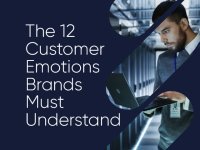7 Important Call Center Skills Every Agent Should Have
Call center representatives must go above and beyond customer expectations to ensure satisfaction. Learn what call center skills are crucial for a gre...
CallMiner Outreach is here! |Learn about the future of CX

Solutions
Products
Customers
Solutions
Products
Customers
Resources
Company
Customer sentiment makes a huge difference for companies of all kinds. However, not all company leaders are aware of the impact that tracking and customer sentiment analysis can make on their bottom line. Various tools can help you track and analyze customer sentiment and emotion, such as:
Here, we'll go over the basics of customer sentiment and explain how it can be tracked so that you can keep your company's objectives aligned with the needs of the people you serve.

Customer sentiment is not unlike sentiment held or expressed by a person towards any other person, place, or thing that they interact with. Sentiment refers to the overall thoughts, views, or attitudes a person has about something — in this case, a brand, product, or service. It’s closely related to emotion, which is more granular, inward-facing, and centered on the feelings individual customers experience, while sentiment is much broader and less detailed.
Unlike similar concepts, such as customer satisfaction or net promoter scores (NPS), customer sentiment is inherently ambiguous. The sentiment someone has towards your brand cannot be rated on a sliding scale in the same way that their satisfaction with an interaction can; it’s typically represented as either positive, negative or neutral. However, customer sentiment can definitely be monitored and improved.
Both direct and indirect customer sentiment are important to keep track of if you aim to maintain a positive brand perception or expand as a company. The two forms are similar, but they manifest in different settings and scenarios.
Direct customer sentiment is arguably rarer than indirect sentiment as it involves a customer directly contacting your company to air their concerns, either in response to outreach on the part of your business or unsolicited. In any event, this form of customer sentiment is best taken seriously, as customers must be fairly motivated to make an effort to explain their feelings to your brand.
Indirect customer sentiment is a lot like direct customer sentiment in that customers are acting on a need to express their feelings about a brand. However, instead of directing their statements toward the brand in question, they choose to voice their concerns (or praises) publicly. Nowadays, that generally translates to posting on social media and engaging in conversations online. This can be a great thing when customers are simply enthusiastic about a brand they adore, but it can become a PR nightmare for companies caught in the crosshairs of disgruntled customers making their grievances known far and wide.
When customers interact with your brand, their perception becomes their main takeaway — that is, their sentiment towards your brand will be the deciding factor for whether or not they continue to do business with you. This makes customer sentiment crucial for businesses of all kinds to monitor and proactively improve.
Negative sentiment can cause serious problems for an organization, especially if it is made public. Given the amplifying nature of the Internet, a scathing review can reach an enormous number of people around the world in very little time. This makes effective customer sentiment analysis more useful as a proactive tactic than a reactive one.
Of course, tracking customer sentiment can do a number of valuable things for your organization beyond proactive damage control. Here are a few of the top benefits you can expect from a solid customer sentiment-tracking strategy:
A product that elicits a positive emotional response from customers is almost guaranteed to be a successful product for your company. You can encourage your customers to communicate directly with your brand to gauge their perception or implement an indirect monitoring approach online to learn how they feel instead.
You can even combine those two approaches with reasonably actionable results. As long as you pay close attention to customer sentiment as people interact with your product, you should be able to improve its performance on the market over time.
Sentiment analysis not only helps you understand product performance but also the overall perceptions of your brand and the effectiveness of your marketing campaigns. By tracking customer sentiment continuously, you can immediately correct your course if a campaign isn’t resonating with your target audience.
Customer retention is much easier when your organization offers top-notch support. Customer service always matters to your customers. Microsoft reports that 9 out of 10 customers consider customer service as a factor when deciding whether to do business with a company, and as many as 58% of all consumers in the U.S. actively switch companies in response to poor customer service.
The CallMiner Customer Churn Index 2020 found that 73.7% of customers will switch companies after having a negative experience with a call center, and 90% will remain loyal after a positive call center interaction. What’s more, 143% more customers experience a positive change in emotion than a negative change in emotion after engaging with a call center. The CallMiner Customer Churn Index 2020 revealed three primary drivers of these positive changes in emotion:
By monitoring customer sentiment, you can keep track of what your team has gotten right and where they may have made mistakes that negatively impacted customers' perceptions of your brand, then make immediate improvements in agent behavior and other factors to cultivate positive customer sentiment and loyalty.
Now that you know just how important tracking customer sentiment can be for your business, you should also learn what options are available for doing so. The following are fairly common and accessible to businesses of all sizes:
Simple surveys can help your company come up with the information that it needs to power all kinds of growth strategies. Email surveys and in-person questionnaires are classic avenues to try out, but you can also embed surveys into key parts of your sales and support processes to learn more about sentiment at these critical moments in the customer's journey.
There are a number of practical brand monitoring tools on the market that make it possible for even a small team to keep up with brand mentions all over the web. Using such tools can pair particularly well with omnichannel contact center operations as social mentions can be addressed in real-time.
A robust conversation intelligence platform like CallMiner can perform real-time analysis powered by AI on interactions between customers and your support staff, yielding amazing customer sentiment and emotion insights you can use to improve performance, retain customers and attract new ones. Best of all, this process can be seamlessly incorporated into the interactions your team members are already having with your customers.
Customer sentiment is a crucial metric to track for every business. Conducting customer sentiment analysis with tools like conversation analytics can help you improve customer service, guide agent behavior, and gain valuable insights into how your products and marketing campaigns are resonating with your audience so you can adapt readily and optimize the customer experience.
CallMiner is the global leader in AI-powered conversation intelligence to improve customer experience (CX). CallMiner delivers the industry’s most comprehensive platform to analyze omnichannel customer interactions at scale, combining deep domain expertise with cutting edge AI analytics and machine learning. By uncovering better intelligence, CallMiner enables companies to identify areas of opportunity to drive better experiences, ultimately leading to business improvement, growth and transformational change. CallMiner is trusted by the world’s leading organizations across all major verticals including technology, media and telecom (TMT), retail, manufacturing, financial services, healthcare, and travel and hospitality.

